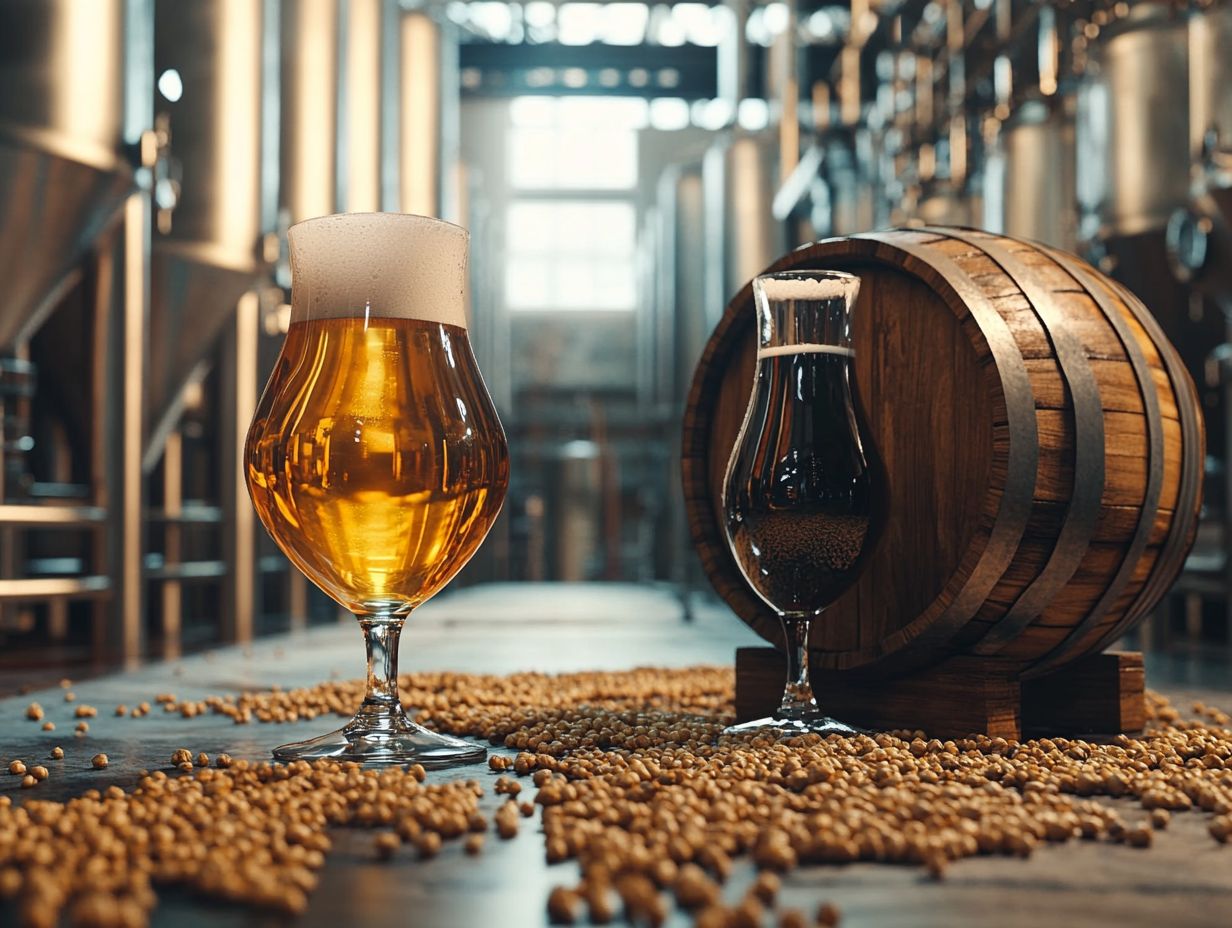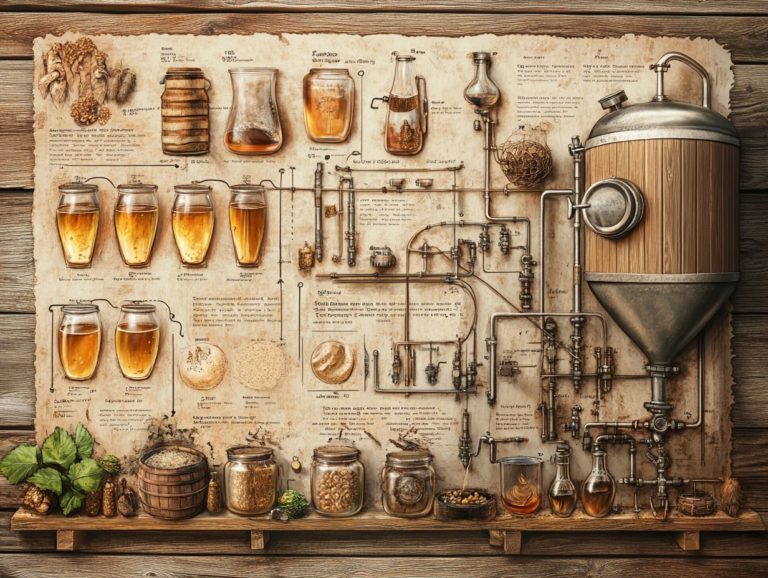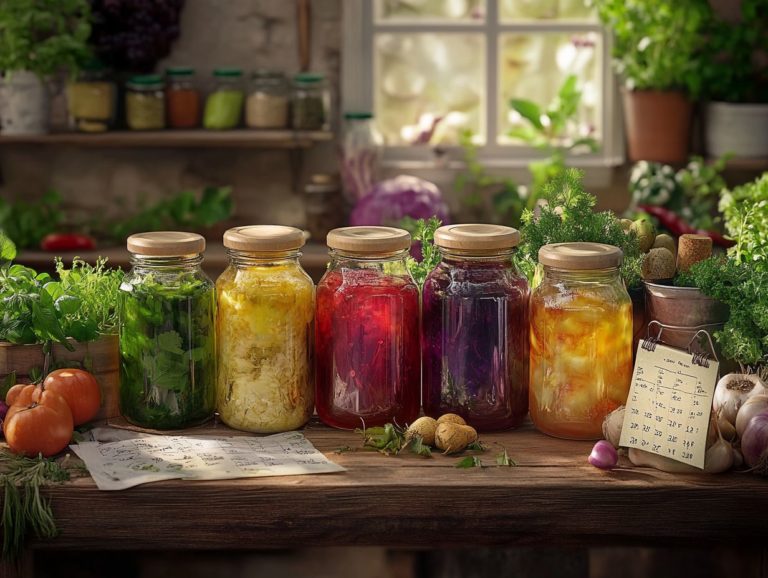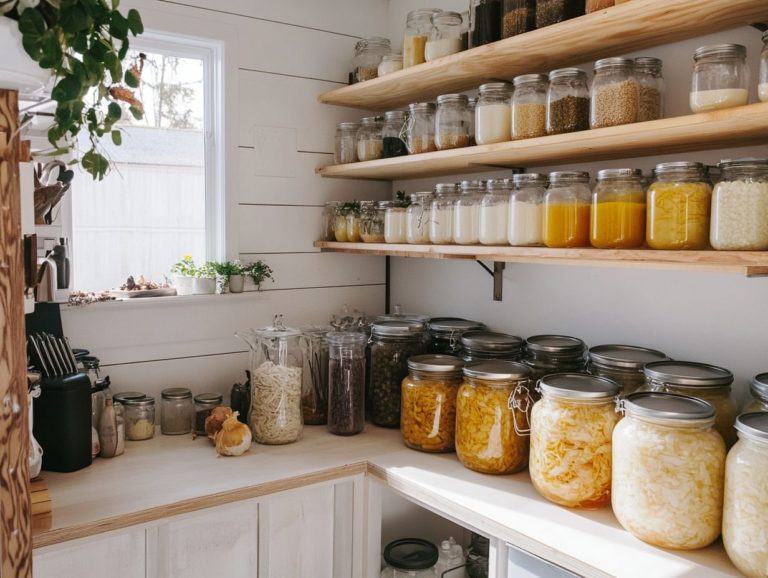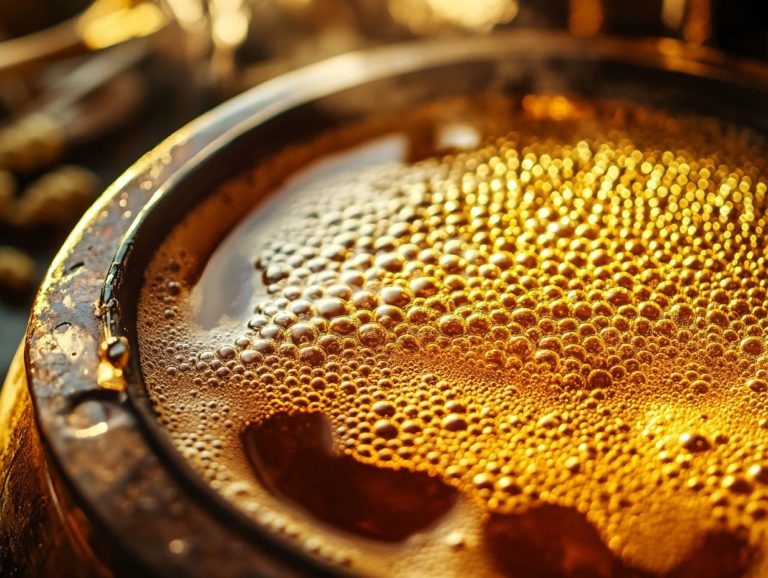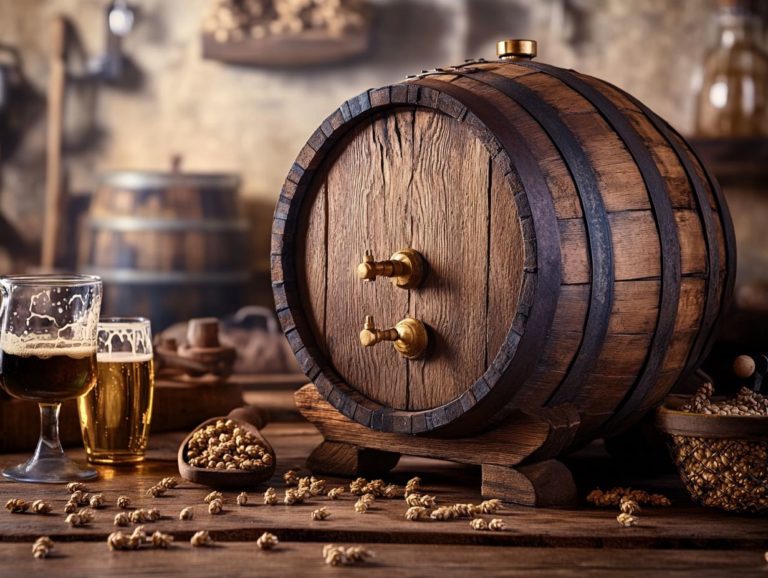Understanding Lager vs. Ale Fermentation
When you embark on the journey of brewing beers, the fermentation process emerges as a pivotal factor that shapes the final flavour and character of your creation.
This exploration delves into the essential differences and similarities between lager and ale fermentation, illuminating the various yeast strains employed, the temperature variations that come into play, and the fermentation durations involved. You ll discover how these elements impact the beer s flavour profile, from esters to sulfur compounds, and even how hybrid styles like K lsch and Altbier fit into the broader brewing landscape.
Moreover, this guide will assist you in selecting the right fermentation style tailored to your flavour preferences and brewing setup. Prepare to elevate your understanding and appreciation for these two distinct types of beer, including traditional types of beer like Pilsner, IPA, and other beer styles!
Contents
- Key Takeaways:
- What Are the Differences Between Lager and Ale Fermentation?
- What Are the Similarities Between Lager and Ale Fermentation?
- How Does the Fermentation Process Affect the Taste of Beer?
- Which Type of Beer Fermentation Is Right for You?
- 1. Flavor Preferences
- 2. Brewing Equipment
- 3. Time Constraints
- Frequently Asked Questions
- What is the main difference between lager and ale fermentation?
- What is the ideal temperature for lager fermentation?
- Can lagers and ales be fermented at the same temperature?
- How long does lager fermentation typically take?
- Do lagers and ales have different flavor profiles?
- Can lagers and ales be brewed using the same ingredients?
Key Takeaways:
What Are the Differences Between Lager and Ale Fermentation?
The differences between lager and ale fermentation lie in their unique brewing processes, which profoundly impact the final taste, aroma, alcohol volume, and overall character of the beer.
As you explore the two primary categories of beer, you’ll notice that they each rely on different yeast strains Saccharomyces pastorianus for lagers and Saccharomyces cerevisiae for ales each lending its own distinctive qualities. Understanding these yeast differences is fundamental to mastering the brewing process, whether you’re aiming to craft a smooth lager or a rich flavour ale.
Grasping these variations can elevate your appreciation of craft beer and guide your selections based on the flavors, temperatures, and complexities you desire in your drink.
1. Yeast Strains Used
Yeast strains are a key factor that sets lagers and ales apart, with each style leaning towards a specific strain that shapes the fermentation process and the character of the resulting beer. Lagers employ Saccharomyces pastorianus, a bottom-fermenting yeast that excels at cooler temperatures, while ales utilize Saccharomyces cerevisiae, a top-fermenting yeast that thrives in warmer conditions. This distinction is crucial in brewing, affecting everything from yeast activity to the final flavour profile of the beer.
The cooler fermentation environment for lagers often yields a clean, crisp taste, accompanied by fewer fruity esters and phenols. This creates a smooth palate that elegantly showcases the malt and hops. In contrast, ales, which ferment at higher temperatures, typically present a more intricate flavour profile, bursting with fruity notes and spicy notes that arise from the vigorous activity of the yeast.
This distinction in fermentation behavior not only defines the overall taste and aroma of each style but also demands different brewing techniques. Timing and temperature controls become essential, enabling brewers to skillfully craft their desired end products with precision and flair.
2. Fermentation Temperature
Fermentation temperature is vital in defining the taste and style of both ales and lagers. You ll want to pay attention to the specific conditions needed for optimal yeast performance.
Lagers typically undergo cold fermentation at lower temperatures, around 45-55 F (7-13 C), resulting in a clean and crisp flavor. In contrast, ales thrive at warmer temperatures of 60-75 F (15-24 C), producing a richer and more complex flavor profile.
The impact of these temperatures goes beyond just fermentation; it actively shapes the aromatic compounds and flavor compounds that affect taste that define the beer’s identity. For instance, fermenting ales at higher temperatures encourages the creation of fruity and floral notes, enhancing your sensory experience.
Cooler conditions favored by lagers suppress these flavors, leading to a more subdued and refined profile.
This differentiation doesn t just affect your immediate taste; it also influences how the beer evolves over time, shaping characteristics like mouthfeel and overall drinkability. Experimenting with these temperature ranges can yield surprising and delightful results. This is an exciting opportunity for brewers to experiment and create exceptional beverages!
3. Fermentation Time
The time you spend fermenting your beer is a pivotal factor distinguishing lagers from ales, profoundly influencing the beer’s flavor complexity and overall quality. Ales typically enjoy a shorter fermentation window of 5 to 14 days, allowing you to savor them faster.
On the other hand, lagers require a more patient approach, fermenting for 3 to 6 weeks, including a vital cold conditioning phase that enhances their smoothness and cultivates a clean, crisp profile.
This variation in brewing timelines is essential because it allows each style to develop its unique characteristics and flavors. Ales, with their quick fermentation, often burst with vibrant fruitiness and bold aromas, appealing to those who appreciate a more robust experience.
In contrast, the leisurely fermentation of lagers lends itself to a crisp, subtle profile, with flavors that are elegantly restrained yet incredibly refined.
Understanding the importance of fermentation time is crucial, as it shapes the experience you seek. This makes it a fundamental consideration for any brewer aspiring to perfect their craft. Explore these fermentation techniques and elevate your brewing game!
This concept is often highlighted in brewing literature, including esteemed publications like Craft Beer & Brewing Magazine.
4. Flavor Profile
The flavor profiles of lagers and ales diverge significantly, shaped by their unique yeast strains, fermentation processes, and the ingredients that define them. You ll find that lagers often deliver a crisp, clean taste with a hint of subtle malt sweetness.
In contrast, ales present a more complex profile, showcasing fruity notes and a pronounced hop character that cater to a variety of palates and preferences.
This distinction stems largely from the fermentation temperatures and methods employed. Lagers typically undergo cool fermentation, resulting in their signature smooth finish.
On the other hand, ales ferment at warmer temperatures, allowing for a fuller expression of fruity esters and phenolic compounds.
Take, for instance, a Pilsner a type of lager celebrated for its light body and refreshing bitterness, making it an ideal choice for warm weather. In contrast, an IPA (India Pale Ale) boasts a bold hop character and a delightful array of citrus and tropical fruit aromas, perfect for those who seek a more robust drinking experience.
- Pilsner: Light body and refreshing bitterness.
- IPA (India Pale Ale): Bold hop character with citrus and tropical fruit aromas.
- Helles: A smooth and malty lager.
- Brown Ales: Rich and caramel-like sweetness.
- Amber Ales: Balanced malt and hop profile.
- Stouts: Dark, rich flavors with coffee and chocolate notes.
Each style reflects its brewing heritage and invites you on a journey through a spectrum of taste sensations. For example, the history of Pilsners can be traced back to the Czech Republic, while IPAs are rooted in England.
What Are the Similarities Between Lager and Ale Fermentation?
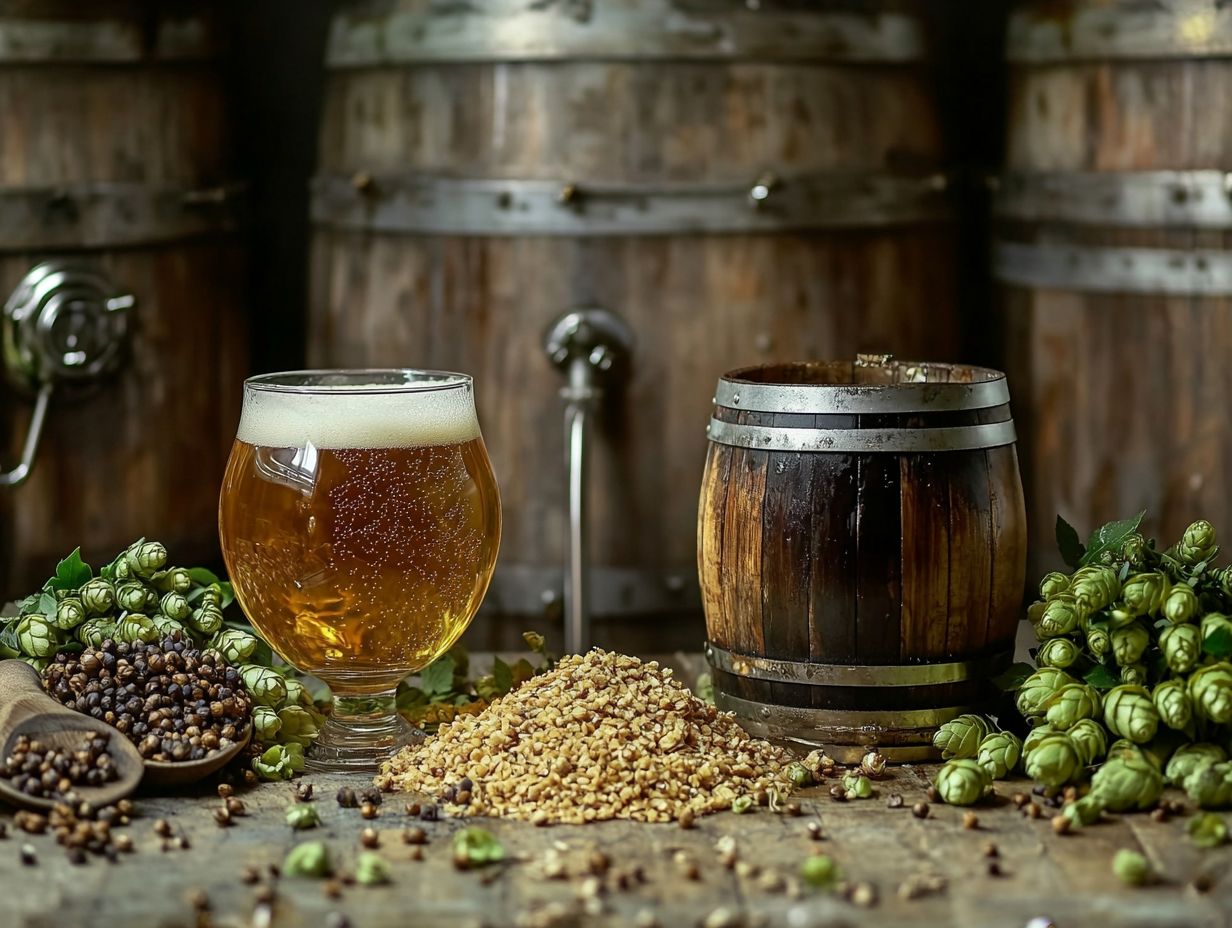
Lager and ale fermentation are distinct, yet they share foundational similarities that are crucial to the brewing process. These similarities give rise to the diverse beer styles cherished worldwide. Whether brewing in California, North America, or Germany, these fundamental processes remain constant.
Both styles rely on fermentation, where yeast transforms sugars from malt into alcohol and carbon dioxide. This process creates the beloved beverages you enjoy. They frequently use common ingredients like hops, malt, and yeast, each playing an important role in shaping the beer’s flavor and aroma.
1. Basic Process
The brewing process for lagers and ales involves several crucial steps. Fermentation is where yeast transforms ingredients into the beloved beverage known as beer.
It all begins with malted grains, which are mashed to extract their sugars. This sweet mixture is boiled with hops, adding bitterness and flavor, before yeast is introduced to start fermentation. The brewing temperature and yeast type determine whether you will create a top-fermenting ale or a bottom-fermenting lager.
This transformation starts with mashing, where heated water mingles with crushed malt to create a sweet liquid called wort. The wort then undergoes boiling, which sterilizes it and allows the hops to infuse their distinctive aromas and flavors. The choice of hop varieties can significantly shape the beer’s final taste.
Once boiling is complete, the wort is cooled and transferred to a fermentation vessel, where yeast is added. During fermentation, yeast consumes the sugars, producing alcohol and carbon dioxide that contribute to the beer’s profile. This step is crucial for creating the unique flavors you’ll love in your beer!
After several days to weeks of patience, the beer undergoes conditioning, clarification, and carbonation before it is finally ready for packaging and enjoyment. This encompasses traditional brewing methods as well as innovative approaches from modern brewers.
2. Ingredients Used
Both lagers and ales rely on a similar set of primary ingredients that are essential to their fermentation processes. This contributes to the remarkable diversity of beer styles found in the craft beer market.
The main ingredients are malted grains, which provide fermentable sugars, hops that add bitterness and aroma, and yeast that drives fermentation by converting sugars into alcohol. You might enjoy exploring different yeast strains and hop varieties by reading insights from Craft Beer & Brewing Magazine or similar publications.
These components fuel fermentation and significantly shape the final flavor profiles of the beverages. Malted grains, primarily barley for lagers and various grains for ales, create a rich foundation of malt sweetness and body.
Hops act as the perfect balancing agent, introducing bitterness to counter sweetness while delivering distinctive floral, citrus, or earthy notes, depending on the variety chosen. Yeast is crucial in transforming sugars from the grains into alcohol and carbon dioxide. The selection of yeast strains can lead to vastly different aroma and taste outcomes from fruity ester notes in ales to clean and crisp finishes in lagers.
Together, these ingredients harmonize, crafting the complex and varied world of beer for you to explore and enjoy.
How Does the Fermentation Process Affect the Taste of Beer?
The fermentation process is key in shaping the taste of beer. It produces a variety of compounds that enhance its complexity and overall flavor profile.
Elements such as the yeast strain, fermentation temperature, and duration are crucial in determining the presence of esters, phenols, and other aromatic compounds that define the character of the beer.
Understanding this intricate process is essential for any discerning beer enthusiast who seeks to appreciate and elevate their tasting experience. Have you ever wondered how different yeast strains can change your beer’s flavor?
Understanding the Role of Compounds in Beer Production
Esters and phenols play critical roles in shaping the flavor and aroma of your beer during the fermentation process. These compounds significantly influence the final profile of your brew, making them essential for every brewer to understand.
1. Esters and Phenols
Esters often bring delightful fruity notes, forming through the interaction between yeast and alcohols. In contrast, phenols can introduce spicy or clove-like characteristics, particularly noticeable in specific ale styles.
These fascinating compounds result from how yeast works during fermentation. Different yeast varieties affect the speed and efficiency of fermentation while also dictating the specific types and concentrations of esters and phenols produced.
For example, some strains may deliver a more pronounced fruity ester profile, amplifying the overall fruity character of your brew. Others may highlight phenolic flavors, enriching your beer with complexity and depth.
Fermentation conditions, such as temperature and oxygen availability, can refine the development of these compounds. This is why brewers meticulously select yeast strains to achieve the desired flavor and aroma profiles, ensuring that every sip of beer is a remarkable experience.
2. Diacetyl
Diacetyl is a compound that can surface during fermentation and lead to an unwelcome buttery flavor in your beer if not managed properly. Both lager and ale fermentations can produce diacetyl, but success lies in ensuring robust yeast activity to reabsorb this compound before the beer reaches its final form.
To fully understand diacetyl, it s crucial to note that it forms as a byproduct of yeast metabolism during fermentation. Certain yeast strains, especially when stressed due to insufficient nutrients or improper fermentation temperatures, are primarily responsible for its production.
The presence of diacetyl can significantly alter the overall flavor profile, detracting from the intended taste of your beer. To manage this, allow for ample conditioning time and implement a diacetyl rest, where you slightly raise the temperature toward the end of fermentation. This simple step encourages the yeast to clean up those unwanted byproducts, resulting in a cleaner, more enjoyable beer.
3. Sulfur Compounds
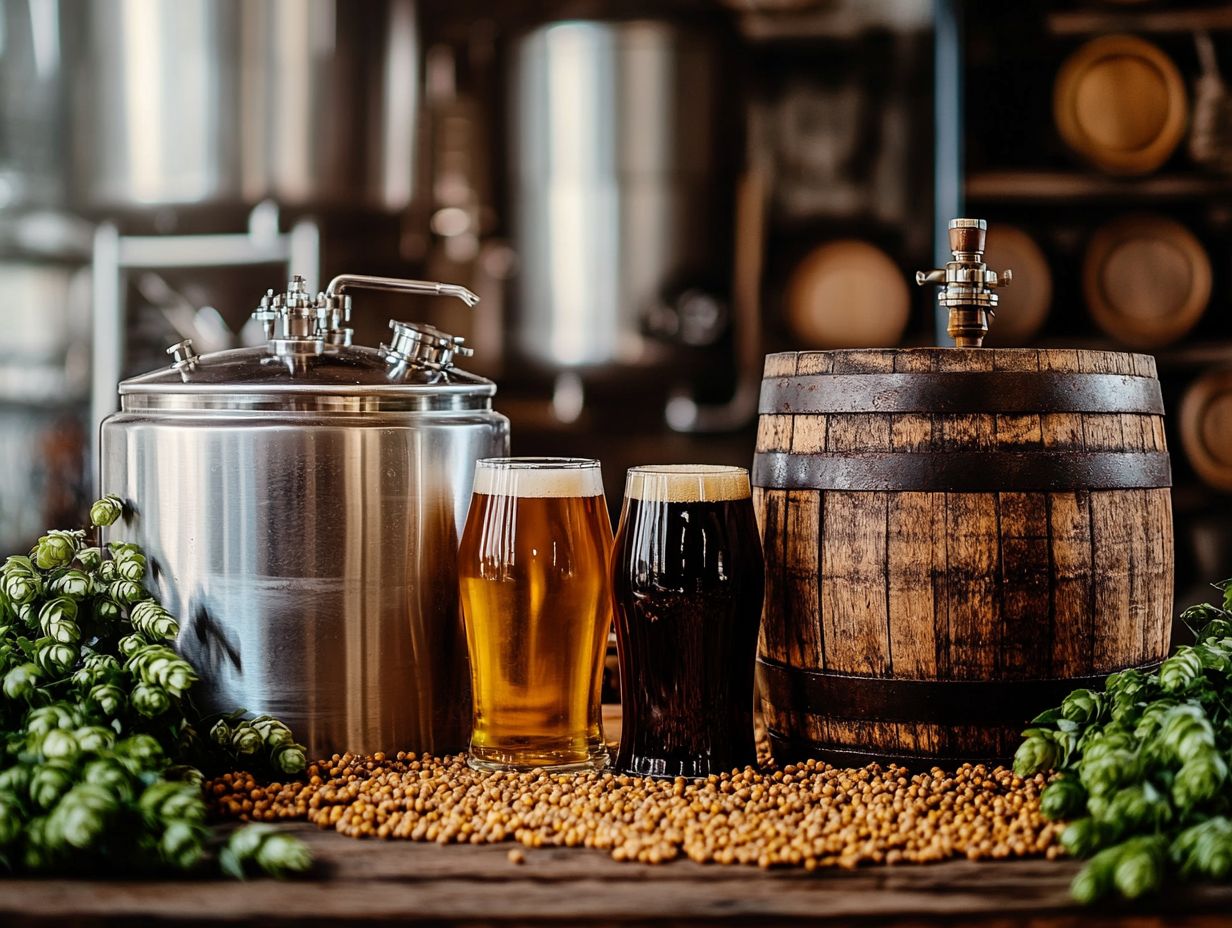
Get ready for the fascinating world of sulfur compounds that can elevate your beer’s flavor! These compounds can emerge during fermentation, significantly shaping the overall flavor profile of both lagers and ales. While some may find these compounds less appealing, they can introduce complexity and depth to the beer.
Certain styles of lager and ale even celebrate these flavors, offering a uniquely enjoyable tasting experience. These sulfur compounds, such as hydrogen sulfide and dimethyl sulfide, are typically generated by yeast during fermentation, stemming from the metabolic processes at work.
When managed properly, these compounds can elevate the beer’s aroma and add intriguing characteristics that harmonize with other ingredients, resulting in a well-rounded profile. However, excessive levels can produce off-putting flavors reminiscent of rotten eggs or cooked vegetables, deterring from the overall enjoyment of the brew.
Brewers must act quickly to strike the right balance; by carefully controlling fermentation conditions and ensuring yeast health, they can ensure that any sulfur notes enhance rather than hinder the final product, ultimately enriching the sensory experience for consumers.
4. Alcohols
Alcohols, especially ethanol, are an important part of the fermentation process. They play a key factor in shaping the taste and body of beer. You ll notice that the concentration of alcohol varies significantly across different beer styles. Some craft beers even manage to reach impressive alcohol volumes while achieving a harmonious balance of flavor and aroma.
During fermentation, yeast works its magic by turning sugars into alcohol and carbon dioxide. This exciting transformation creates unique flavors that define the final product. Higher alcohol content can enhance a beer’s mouthfeel and flavor profile, imparting a rich and warming sensation found in styles like imperial stouts and barleywines.
In contrast, lighter beers such as pilsners and session ales typically offer a crisper finish. Here, lower alcohol levels contribute to a refreshing experience. These distinctions illustrate how fermentation and alcohol interact, influencing taste and enriching the overall sensory journey for beer enthusiasts.
Which Type of Beer Fermentation Is Right for You?
Choosing the right type of beer fermentation to match your taste preferences, brewing equipment, and time constraints can significantly enhance your homebrewing experience. It will also boost your appreciation of craft beer.
Whether you enjoy the fruity complexities of ales or the crisp precision of lagers, understanding the subtleties of each fermentation style will help you make well-informed choices throughout your brewing journey.
1. Flavor Preferences
Flavor preferences are vital in guiding your exploration of lager or ale fermentation styles. Each offers a uniquely enticing tasting experience. If you prefer crisp, clean tastes with a hint of subtle malt sweetness, lagers will likely catch your interest. On the other hand, if you crave bold, fruity notes and complex flavor profiles, ales might suit you better.
Understanding these differences can greatly enhance your craft beer journey. Lagers are fermented at cooler temperatures, resulting in a smooth mouthfeel and a refreshing finish. This makes them an excellent choice for casual sipping or pairing with lighter dishes. Conversely, ales are brewed at warmer temperatures, allowing for richer, more adventurous flavors think caramel, dark fruits, or even floral undertones.
By recognizing these distinctive characteristics, you can tailor your selections to match your personal preferences. Whether you desire something laid-back or are eager to dive into more intricate flavor profiles, you have options.
2. Brewing Equipment
The choice of brewing equipment greatly affects which fermentation method suits your needs. The requirements for lagers and ales vary. Ales typically demand less specialized gear, giving you greater flexibility in your homebrewing setup.
For anyone keen on crafting their beverages, understanding the nuances of brewing processes is essential. A simple fermentation bucket may suffice for ales, which thrive at warmer temperatures and ferment quickly.
However, if you’re ready to dive into brewing lagers, investing in a reliable fermentation chamber or temperature control system is crucial. This equipment ensures fermentation occurs at the ideal cooler temperatures. It also helps cultivate the smooth flavors and crisp finishes that lagers are known for.
Thus, selecting the right brewing equipment is key to achieving the results you desire.
3. Time Constraints
When weighing your options between lager and ale fermentation, time constraints become a pivotal factor. These styles have notably different fermentation periods. If you’re eager to brew and savor your craft beer sooner, ales are your best bet. They require significantly less time.
Lagers require more patience. Their fermentation and conditioning processes can extend well beyond a typical brewing timeline.
With ales, you can expect the fermentation to last about one to two weeks. This quick process lets you brew more often and try new flavors! In contrast, lagers can take a month or even longer. This necessitates extended cold storage that s essential for achieving that signature clean taste and crisp finish.
For many brewers, the juggling act of work, life, and brewing commitments often leads to prioritizing styles that harmonize with their available time. This penchant for ales among those who desire to produce beer without the prolonged wait emphasizes how crucial effective time management is in the brewing decision-making process.
Frequently Asked Questions
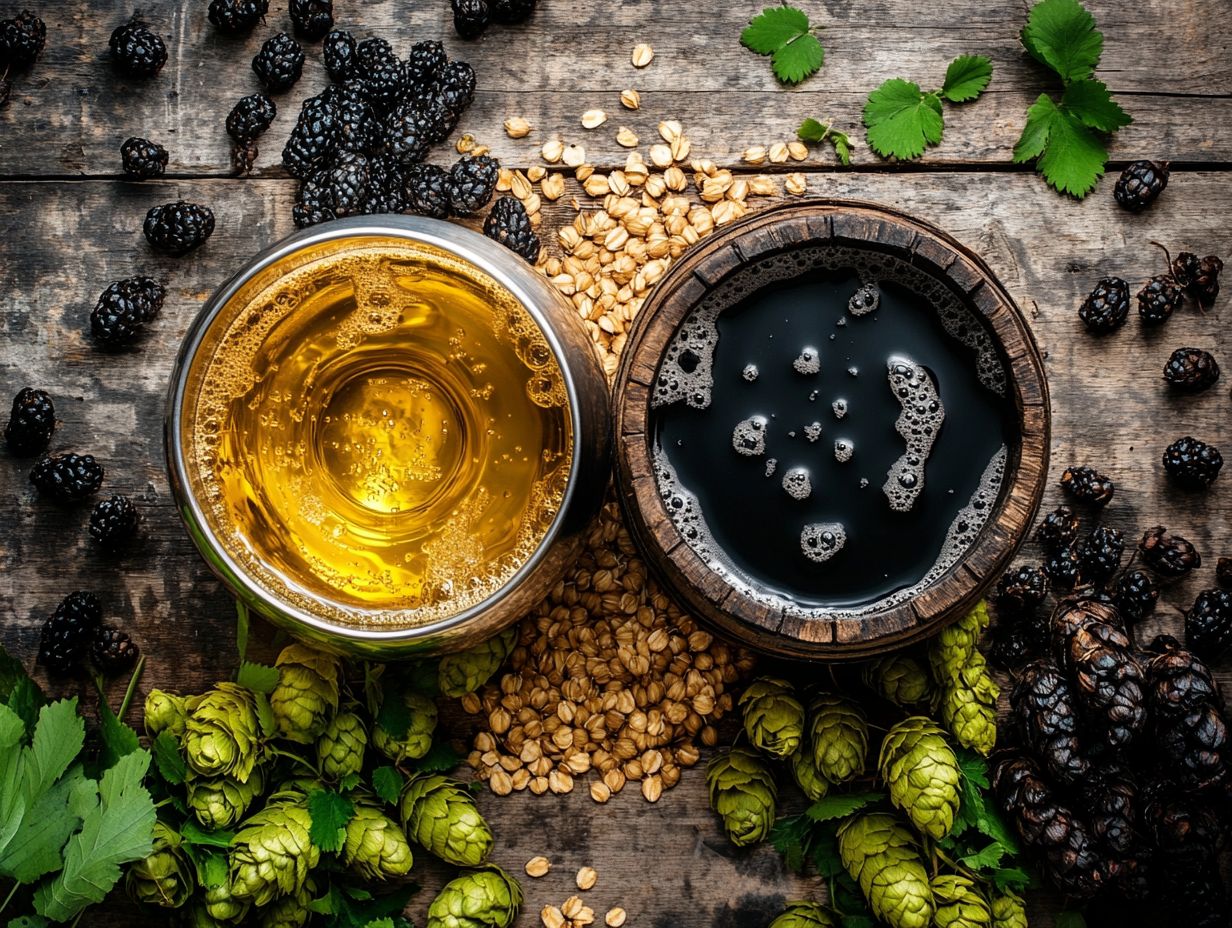
What is the main difference between lager and ale fermentation?
The main difference is the type of yeast used. Lager uses yeast that ferments on the bottom, while ale uses yeast that ferments on the top.
What is the ideal temperature for lager fermentation?
The ideal temperature for lager fermentation is between 45-55 degrees Fahrenheit. This is much cooler than ale fermentation temperatures.
Can lagers and ales be fermented at the same temperature?
No, lagers and ales require different temperatures for fermentation due to the different types of yeast used. Fermenting at the wrong temperature can result in off-flavors and a failed batch.
How long does lager fermentation typically take?
Lager fermentation takes longer than ale fermentation. It usually lasts around 1-2 weeks, followed by a period of cold storage for an additional 4-6 weeks.
Do lagers and ales have different flavor profiles?
Yes, the type of yeast used in fermentation greatly affects the flavor profile of the beer. Lagers tend to have a smoother, cleaner taste, while ales have a more complex and fruity taste.
Can lagers and ales be brewed using the same ingredients?
Yes, lagers and ales can be brewed using the same ingredients. However, the type of yeast and temperature used for fermentation will result in different end products. It’s important to choose the right ingredients for the desired beer style.

